
ICCROM_ICS01_CeramicaDecorada00_es
.pdf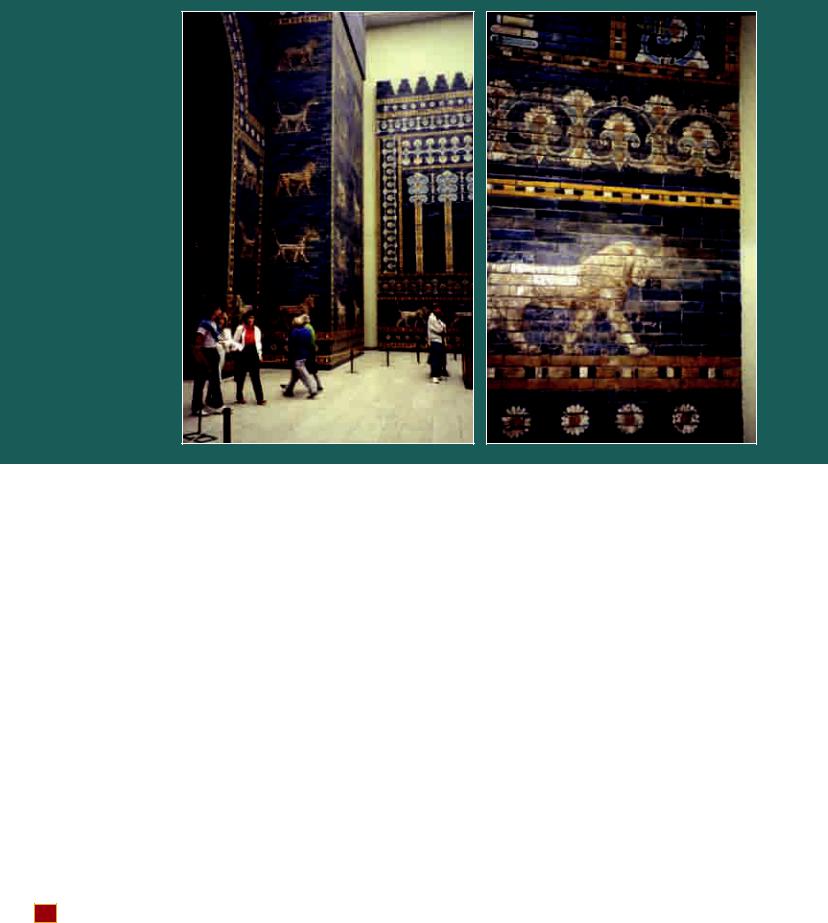
FIGURA 4 (a sinistra) Berlino, Staatliche Museen, ricostruzione della Porta di Ishtar, già a Babilonia
(foto dell’Autore).
FIGURA 5 (a destra) Berlino, Staatliche Museen, ricostruzione della Porta di Ishtar, già a Babilonia; particolare del paramento ceramico (foto dell’Autore).
tendenziali, pure la funzione positiva di spie o indici circa la progressione dello stato di salute statico delle compagini e che, quindi, a parte semplici otturazioni, devono poter essere controllate nel tempo). Inoltre, come nell’ultimo caso appena esposto, sussistono forme di degrado affini a quelle che riguardano i rivestimenti lapidei, del resto (ma lo strato vetroso rimane assai delicato e soggetto), scaturenti da esposizione al clima marino (per i sali e le smerigliature, indotte, queste ultime, dall’azione eolica); o derivanti da impatto biologico; oppure generati da un microclima di natura acida; ovvero prodotti da sporcizia e detriti accumulati ed incrostati, o persino da preparati nelle intenzioni apposti quali ‘protettivi’ nel passato, e così via. Da quanto precede, possono innanzi tutto discendere attutimenti rispetto al pieno dispiegarsi delle qualità figurative dell’invetriata.
Ma particolarmente grave è certo, per paramenti smaltati, oltre che la scomparsa di singoli elementi, la caduta del rivestimento stesso, su base fittile così inopinatamente palesata, quale che ne sia l’origine. In effetti, in questa evenienza, l’impatto può essere devastanteefuorviante,adinterromperechiassosamente i ritmi, le armonie, gli equilibri, le continuità e comunque le connotazioni, insieme, figurative,
cromatiche e luministiche dei paramenti. Ed anche un intervento di mera conservazione (insomma, di blocco o congelamento del deterioramento già occorso: preconsolidamento, pulitura, stuccature, consolidamento e protezione, certo, con prodotti tendenzialmente reversibili e con controllati strumenti manuali) non riuscirebbe a correggere, né a placare (ma soltanto a non esacerbare ancora), la penosa situazione percettiva venutasi senza dubbio ivi a determinare. Tuttavia, l’alternativa del ripristino, sempre ammesso che sussistano oggi persistenze di lavorazioni, maestranze ed artigiani ad hoc, non rappresenta una vera soluzione, ma una scorciatoia sbrigativa e semplicistica, stante l’inautenticità storica che, subdolamente, verrebbe via via sempre più a caratterizzare l’oggetto intero, pervadendolo.
Del resto, ben di rado è stato affrontato, con rigore, con cognizione di causa e con pienezza di argomentazioni, il concernente e fondativo tema del rapporto fra il restauro e l’estetica. Vale a dire, il nesso con la contemporanea filosofia dell’arte, non con un’estetica approssimativa, alla buona ed abborracciata, ben oltre apparenti ovvietà circa le necessarie compiutezza ed omogeneità dell’opera. È questo il nodo, il passaggio ineludibile, che può condurre a
54 El Estudio y la Conservación de la Cerámica Decorada en Arquitectura
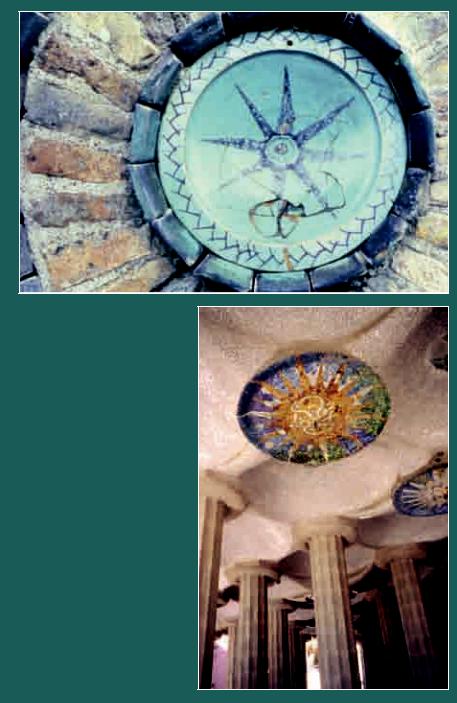
FIGURA 6 Roma, Basilica di Santa Maria Maggiore, bacino ceramico inserito nel campanile
(foto dell’Autore).
FIGURA 7 Barcellona, Parco Güell, dettaglio della Sala Hipóstila (foto dell’Autore).
soluzioni, certo non a ricette non cercate e non richieste, valide per ogni circostanza, tanto più in presenza di esempi ogni volta vari e differenti, già sotto il profilo storico e figurativo, oltre che sotto il riguardo dell’impostazione critico-conservativa più adeguata alla bisogna.
È chiaro, però, che esistono pur sempre delle casistiche, sulle quali, appunto, dottrinalmente ed empiricamente basarsi e su cui svolgere ragionamenti teorico-operativi, come qui si sta tentando di fare.
Le soluzioni praticabili, comunque, come per i pavimenti ed i rivestimenti interessati da risanare, possono essere talora, ma solo in presenza di un’accertata extrema ratio, radicali, come l’espianto ed la bonifica, seguiti dal reimpianto. Ma, allora, rimane addirittura imprescinbibile un preventivo rilievo esatto e ravvicinato o un calco a pezzature, così da consentire una ricollocazione effettivamente precisa e rigorosa e, comunque, la preordinata redazione di una documentazione inoppugnabile, in ogni modo e comunque necessaria quale elemento di possibile riscontro. In presenza di pregresse traslazioni, poi, di singole cellule, o ancor peggio, di pannelli esemplificativi (sic) di impiantiti già pesantemente depredati e/o soggetti a consunzione in passato, non si può chiedere al restauratore odierno una sorta di miracolo.
In ogni modo, nella prima circostanza, si tratta di un delicato problema storiografico, a fronte del possibile, indotto fuorviamento dell’osservatore. Se la situazione dell’opera è ormai consolidata, sotto i riguardi storico-estetico, così da farla risultare, magari, mentalmente rileggibile, nelle sue versioni anteriori, anche tramite l’ausilio di pannelli con rilievi e restituzioni grafiche, allora non è necessariamente il caso di agire emendativamente in corpore vili. Nell’eventualità, invece, di una situazione caotica, forse si può pure assumere in considerazione un intervento di restauro di riordino, purché la situazione pregressa venga ampiamente documentata, purché lo siano anche le fasi intermedie e quella primiera, purché non si concretizzino ipotesi ma certezze, purché, infine, il valore dell’insieme possa così essere almeno in parte recuperato e non, certo, depauperato ulteriormente. In ogni modo, è sempre possibile e prudente agire con un genere di musealizzazione indiretta, vale a dire collocando nei pressi del manufatto, semplicemente mantenuto come tale (tramite le canoniche opere di conservazione in situ), delle bacheche o dei pannelli fotografici e/o graficizzati, ovvero delle simulazioni al computer (comunque, il tutto disposto su elementi mobili), ove siano leggibili, ricostruendole idealmente, le situazioni pregresse. Insomma, quanto taluno sarebbe in effetti tentato di realizzare nuovamente sul vivo, così inesorabilmente retrocedendo se stessi e l’opera, di fatto e magari non del tutto consapevolmente, nel tempo storico.
Nella penosa circostanza dianzi esternata, poi, quella di pannelli esemplificativi con pezzi espiantati ed estrapolati, magari in funzione del mercato antiquario, o d’ingenua impresa di presunto ‘salvataggio’, susseguente o meno ad una vera depredazione, il rimedio, ormai, può essere assai arduo, se non, ora a cose fatte, impossibile. Naturalmente, se vengono ritrovati ulteriori elementi, se le rispettive collocazioni originali (non
Capítulo 2 Teoría, criterios e intervención |
55 |
|
|
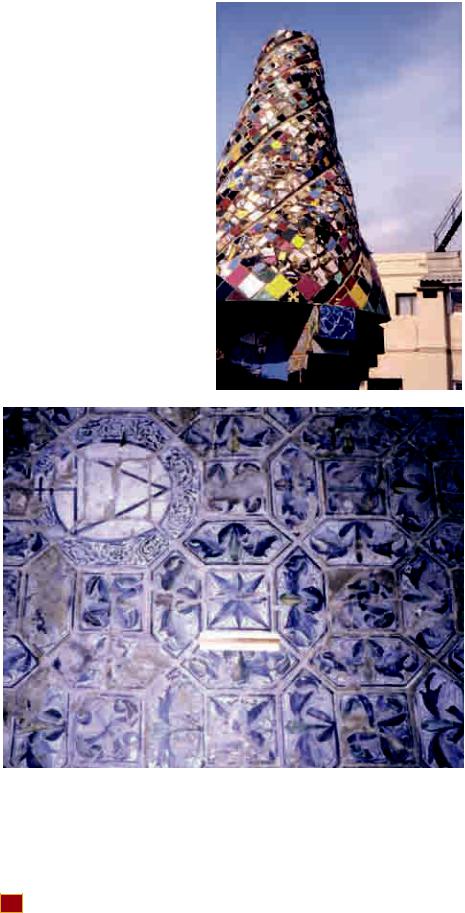
FIGURA 8 Barcellona, Palazzo |
|
|
|
ad una ricollocazione in situ anche parziale. |
|||||
|
|
|
|||||||
|
|
|
Purché questa si fondi su dati certi e si palesi |
||||||
Güell, particolare della terrazza |
|
|
|
||||||
|
|
|
nella sua |
identità |
di, magari |
misurato, |
|||
con i comignoli maiolicati |
|
|
|
||||||
|
|
|
intervento |
odierno |
di |
recupero, |
che |
deve |
|
(foto dell’Autore). |
|
|
|
||||||
|
|
|
risultare, in ogni modo, filologicamente |
||||||
|
|
|
|
||||||
FIGURA 9 Viterbo, Santa Maria |
|
|
|
inoppugnabile |
e |
doviziosamente |
|||
della Verità, Cappella |
|
|
|
documentato. |
|
|
|
|
|
Mazzatosta, particolare del |
|
|
|
Le eventuali lacune, per loro conto, non |
|||||
pavimento maiolicato |
|
|
|
andranno mai riguardate a sé, ma sempre in |
|||||
(foto dell’Autore). |
|
|
|
seno all’opera invetriata nel suo insieme e, di |
|||||
|
|
|
|
più, al manufatto architettonico intero su cui |
|||||
|
|
|
|
il rivestimento è innervato. Un tentativo |
|||||
|
|
|
|
interessante da esperire può pure essere quello |
|||||
|
|
|
|
di risarcire le fallanze in termini critico-con- |
|||||
|
|
|
|
servativi, com’è stato fatto nella cappella |
|||||
|
|
|
|
Basso della Rovere in Santa Maria del Popolo |
|||||
|
|
|
|
a Roma, in sintonia con il corrispondente |
|||||
|
|
|
|
filone del restauro architettonico tout court. |
|||||
|
|
|
|
Vale a dire, con linguaggio schiettamente |
|||||
|
|
|
|
contemporaneo, dunque, distinguibile, eppure |
|||||
|
|
|
|
non chiassosamente, non, insomma, in termini |
|||||
|
|
|
|
di insanabile contrasto, in quanto operazione |
|||||
|
|
|
|
come instradata (o ispirata) dal rigoroso |
|||||
|
|
|
|
rispetto ed echeggiamento contrappuntistico |
|||||
|
|
|
|
dell’opera |
originale. |
C’è bisogno, |
qui, |
||
|
|
|
|
insomma, di un’interpretazione penetrante e |
|||||
|
|
|
|
||||||
|
|
|
|
preventiva del soggetto ed, allo stesso tempo, |
|||||
|
|
|
|
di una sapiente esegesi restaurativa in atto, in |
|||||
|
|
|
|
medias res. |
|
|
|
|
|
|
|
|
|
A loro volta, le copie ed i falsi alla fine |
|||||
|
|
|
|
non giovano, soprattutto questi ultimi. Tanto |
|||||
|
|
|
|
più in quanto fanno cadere l’operatore in un |
|||||
|
|
|
|
ginepraio di insanabili antinomie. Infatti, se i |
|||||
|
|
|
|
rimpiazzi mimetici si presentano come nuovi, |
|||||
|
|
|
|
ebbene, essi contraddicono la loro stessa, pur |
|||||
|
|
|
|
presunta ragione d’essere. E comunque |
|||||
|
|
|
|
stridono, con la loro invetriatura rutilante, |
|||||
|
|
|
|
nei confronti del contesto. Se, invece, questi |
|||||
|
|
|
|
simulano persino il degrado che dovrebbe |
|||||
|
|
|
|
essere intercorso, allora si tratta davvero di |
|||||
|
|
|
|
una falsificazione in piena regola. La quale, |
|||||
|
|
|
|
più di ogni altra cosa, pervasivamente inganna |
|||||
|
|
|
|
il riguardante circa l’autenticità non solo dei |
|||||
|
|
|
|
pezzi, isolatamente assunti, ma, di più, |
|||||
|
|
|
|
dell’intero |
contesto |
dell’opera. |
Sarebbe |
||
|
|
|
|
infirmata, con ciò, l’intima identità medesima |
|||||
|
|
|
|
di questa. |
|
|
|
|
|
|
|
|
|
Quanto, poi, ai bacini, non nati per essere |
|||||
|
|
|
|
posizionati sui monumenti, ma comunque a |
|||||
|
|
|
|
suo tempo inseriti su questi, ebbene, quella |
|||||
|
|
|
|
||||||
necessariamente originarie) vengono a loro volta |
|
|
della copia non può rappresentare una |
||||||
stabilite con certezza ed esattezza, se il contesto |
soluzione, anche per le ragioni appena esposte, oltre |
||||||||
diacronico dell’architettura già ospitante lo consente e |
che per la coerenza, delle più varie nature (storica, |
||||||||
lo legittima senza particolari traumi, allora si può pure |
figurativa, deteriorativa e quant’altro), che deve |
||||||||
addivenire, dopo lo smontaggio dal precario supporto, |
sussistere tra il monumento stesso e le sue componenti |
||||||||
56 El Estudio y la Conservación de la Cerámica Decorada en Arquitectura
decorative. Eventuali indirizzi di intervento ‘filologico’, a loro volta, con le inevitabili semplificazioni derivanti, sono, ormai, datati, altresì in rapporto alla loro pochezza sul piano estetico. Ove impropriamente ed astrattamente si eleva a forma, senz’alcuna mediazione, lo schema, insomma il tipo. Senza avvedersi che fra i due piani esiste un salto assolutamente da colmare, eventualmente a mezzo di un calibratissimo e dialettico, travaglio generativo, ispirato ad una sapiente e rispettosa, ma autentica dialettica con la preesistenza. Il che vale per la situazione appena descritta, ma altresì per le lacune ed il loro eventuale risarcimento.
Ci sono poi, all’interno del tema qui riassunto e schematizzato, ulteriori casi particolari, pure in relazione alla tecnica adottata. Ad esempio, in presenza pur sempre di invetriatura, può darsi l’evenienza contemporanea di sottostanti ingubbiature e/o di graffiti (vedasi Palazzo Ottelio ad Udine), ad esaltare la varietà di tali rivestimenti. Ma anche la specificità di forme eventuali di degrado attinenti, pure in chiave di classi differenziali di degrado. È logico, del resto, che, di fronte ad eterogeneità del rivestimento stesso, il genere di deperimento appena menzionato si possa verificare e venga, anzi, facilitato.
Stabilire regole e norme è, nel campo del restauro, assai pericoloso. Anche perché, dopo tutto, deve esistere una qualche libertà (non arbitrio) dell’operatore, di fronte all’opera, di cui egli deve divenire il vero ed il più esperto conoscitore-conservatore. Al limite, si possono adottare princìpi e vincoli di larga massima. Anche qui, come ovunque, si tratta del minimo intervento, della non invasività, della compatibilità (non identità di tecniche), della reversibilità tendenziale, della misurata distinguibilità, infine, della mancanza di effetti indotti o collaterali. Questi orientamenti sono però da seguire sempre nello spirito del rispetto della sostanza storica ed estetica dell’opera, nella sua piena contestualità, tenendo conto che ogni soggetto è singolo e singolare, irripetibile, là dove proprio queste caratteristiche devono essere tutelate ed anzi tramandate nel massimo grado.
Capítulo 2 Teoría, criterios e intervención |
57 |
|
|
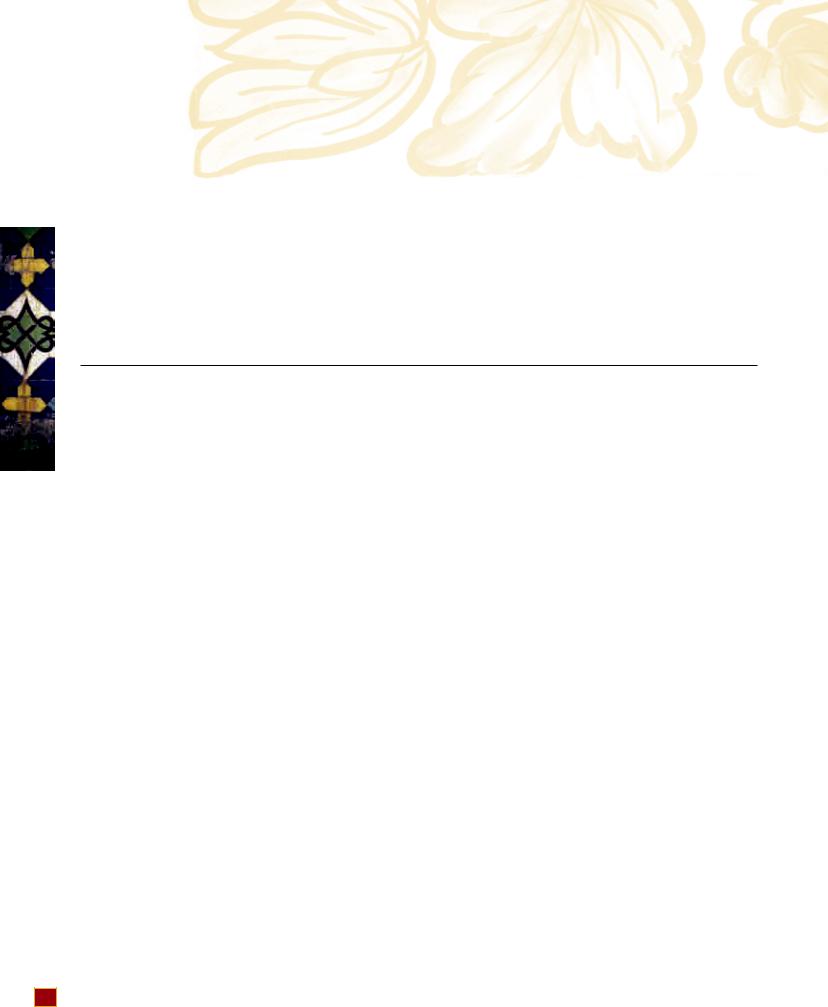
Antoni González Moreno-Navarro, |
] |
[ Architect, Servicio de Patrimonio Arquitectónico Local, Diputación de Barcelona |
Tradition, modernity, synthesis: glazed ceramics in architecture and Gaudí
The mansion, built by Antoni Gaudí between 1885 and 1890 for the Güell family, was acquired by the Barcelona County Council in 1945 and since 1954 it housed some of the departments of the Theatre Institute. When in 1982 the Institution’s own Monument Cataloguing and Conservation Service (today the Local Architectural Heritage Department) took charge of its conservation, the first objectives were to begin work on those maintenance tasks which could not be postponed and to initiate the studies for its restoration, studies which looked both into the historic (conception, erection, transformation and use of the building) and architectural aspects (constructive, compositive and spatial) encompassing from the creation of an “historic-constructive atlas” to the numeric modelling of the building, monitoring its static behavior and analysing the risk of earthquakes.
For some years the lack of budget limited the works to repairs and clean-up tasks, such as that of the main façade, which took place between 1983 and 1984. Since 1986, the
contributions from the Council itself, the Ministry of Culture and the European Community permitted more intense work. Since then, and until 1993, the rest of the façades have been restored, together with the flat roof and, in the interior, the hall, the old coach house and the service staircase. Some installations have also been renovated, part of the original furniture of the mansion was also recovered and the porter’s hall has been brightened up to welcome the visitors who will be the main users of the building in the future.
These works, besides ensuring the appropriate use of the building, seek to recover the authenticity of the monument, which had been lost or damaged during its hundred years of existence due to the perishability of the materials or their incorrect use. The concept of authenticity, however, is not in this case related to the
originality of the matter or to the lack of it, but rather to its capacity (inherited or supplied) for expressing the most genuine aspects (space, shape, texture, colour) of the original work.
To choose the means which would permit this recovery, certain teachings by the masters were taken into account. Firstly, Gaudí himself who, with regards to his intervention in the cathedral of Mallorca, reminded us that restoring is, above all, to “return everything to its place and to its true function” and that to do this “it is not necessary to copy the pre-existing shapes, but rather to produce them within the scope of a certain character which possesses its spirit”. The advice of Leopoldo Torres Balbás was also heeded who, when referring to bis intervention in the Alhambra, said that when restoring one must act with eclecticism and elasticity. Because of all this, mimetic reconstruction was opted for in some cases (repairing or reproducing in accordance with original models the pavings, facings and closures), whereas in other cases an analogous recovery was sought, based on the
58 El Estudio y la Conservación de la Cerámica Decorada en Arquitectura
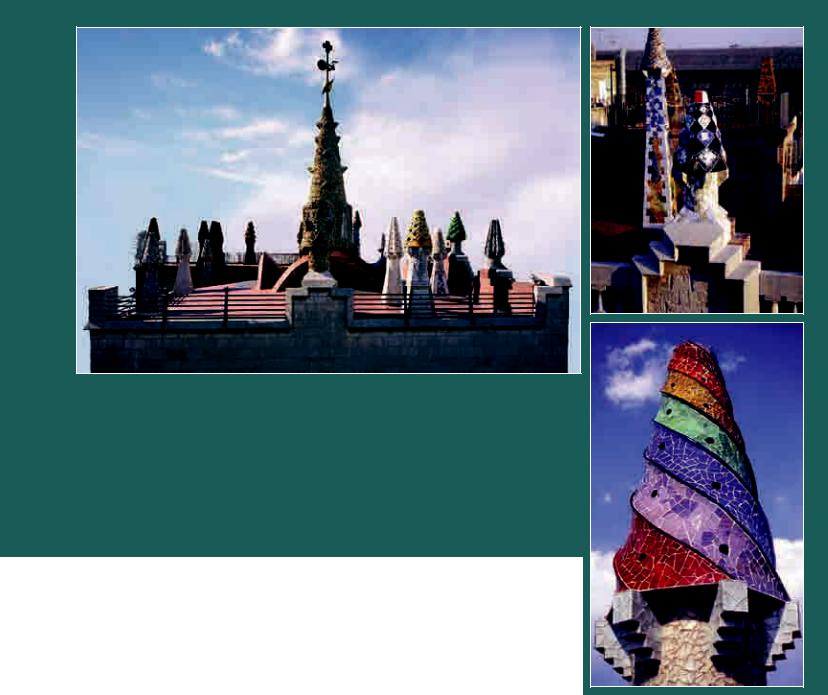
(ABOVE) Azotea del Palacio Güell (1885-1890). Antoni Gaudí, architect. Restoration: Antoni González, architect, 1987-2002. Photo: Baldomà+Grabau, 2002.
(RIGHT ABOVE) Chimney nº 1 (Joan Gardy-Artigas) with, in the background, chimney nº7 (Domingo García-Pozuelo). Photo: Montserrat Baldomà. 13.01.1994.
(RIGHT BELOW ) Chimney nº 2 (Robert Llimós). Photo: Montserrat Baldomà. 26.09.1994.
concept of “harmonious diachrony”, that is, by means of elements which would harmonize with the pre-existing ones and would manifest their diachrony with them thanks to the design or the materials.
The restoration of the façade looking on to the courtyard of the block can be considered as a mimetic reconstruction. The disappeared shutters were replaced with noble woods -in general, mahoganyto match the original models, the umbraculum was rebuilt and the gallery was repaired. In this last element some deteriorated glazed ceramic tiles and some of the forgings were replaced; in the interior the back of the bench was upholstered in Cordoban leather worked in the city of Cordoba, following the original design deduced from the conserved photographic information.
For the clean-up of the stone of this façade every product offered by the specialized market was tried unsuccessfully, and finally a washing-up liquid was employed with excellent results. Of course the stone did not look as white as the salesmen of those miraculous products promised, but after all the aim was merely to clean it. The paving of the terrace posed a new dilemma. During a previous restoration, the
original paving in Garraf limestone (extracted from Mr. Güell’s quarries) was substituted for a less porous stone, more appropriate for outdoors. This
paving was already in poor condition due to the structural movements in the forging, and it was decided to renew it. The doubt was whether to do so with Garraf stone or again with the material used in 1970. The fidelity to Gaudí’s idea that all of the materials employed in the house should come from the promotor’s properties (“all materials were torn from the bosom of our land...”) seemed to be a prioritary question in this case.
The new perimetric lattice -indispensable in order to reinstate the lost privacy of the terracewas made in noble wood, very different therefore from the simple primitive lattice which has disappeared and which was known through photographs, giving priority in this case to the requirements of the new public use of the mansion rather than to the criteria of fidelity to the original.
Capítulo 2 Teoría, criterios e intervención |
59 |
|
|
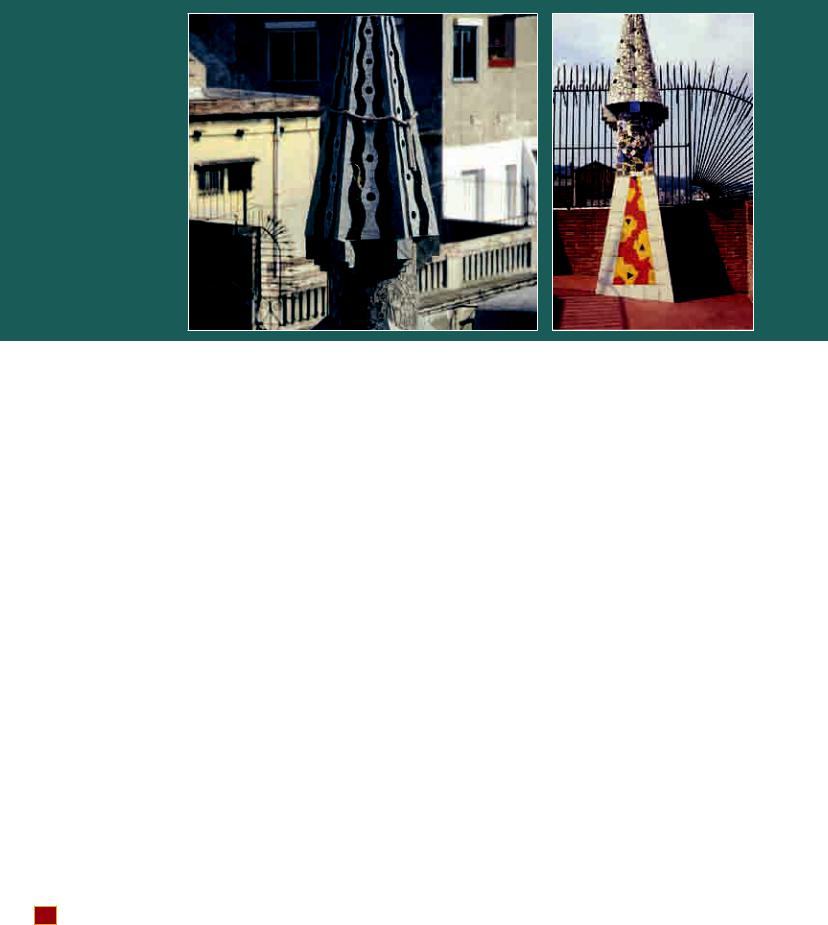
(leFt) chimney nº 4 (Joan Mora). Photo: Montserrat Baldomà. 07.04.1994
(riGHt) chimney nº 5 (Pablo carbó). Photo: Montserrat Baldomà. 19.07.1994.
The roof
The work on the flat roof aimed at facilitating its public use and to highlight the singular elements without losing their character, which was to be a mixture of domestic service terrace and of open-air museum of sculptures. This diversity of objectives and circumstances made this the place where this diversity of attitudes was most manifested, especially in the restoration of the twenty chimneys which surround the central needle crowned by the suggestive lightning conductor-weather vane.
The new public use suggested the improvement of the skylights located next to the three shells or lunettes which furthermore made it difficult to appreciate the undulating movement of the paving. The new square skylights in a copper-clad metallic structure are better adapted to the surface in a solution which is also conceptually nearer to that which was planned in Gaudí’s initial project. Work was also undertaken to correct the precarious situation in which the west facing shell had been left when Gaudí installed the pipes of the organ in the storey immediately below, as they rose above the height of the roof and left the shell constricted between two raised skylights.
When the roof was restored the old organ had been dismantled and the shell could be liberated, not only reinforcing the harmonious relationship of the central lantern with the four lunettes which guard it (and facilitating new perspectives of the roof for the visitors), but also emphasizing the spatial and formal values, previously unnoticed. Through the transparent glass which now closes off the lunette, the spectator
discovers the beauty of the parabolic brick arches’ graded succession which forms the insertion of the shell, and enjoys new oblique perspectives through the central space of the building, similar in intention and feeling to those foreseen by Gaudí from so many other corners of the mansion.
The repairs to the southern lunette were also taken advantage of in order to re-establish communication between the different levels and volumes of this sector of the roof and also to remodel the high section of the staircase niche, rebuilt in accordance with Gaudí’s own design for an adjacent body of the building which at one time must have belonged to the mansion. The materials, which were employed in these repairs, were the same as those used in 1888: manual red brick, lime mortar, wood and iron forging.
The renovation of the pavement of the flat roof, no longer the original one but the result of a restoration carried out in 1972, was made with more resistant materials (ceramic stone and cement mortar), and some constructive improvements were introduced, such as butylic mesh. The formal aspects were based on the data compiled by archaeologists during the trials which were carried out and also involved the introduction of new edging elements in copper which possessed the spirit of the simple primitive flat roof. The restoration of the lantern unveiled the surprise of the cladding material: small fragments of glazed sandstone, conserved in the house, which the Güells had in the Garraf. To fill in the voids other abandoned ovens were searched for in that same area, and they were bought and dismantled. a more simple
60 El Estudio y la ConsErvaCión dE la CErámiCa dECorada En arquitECtura
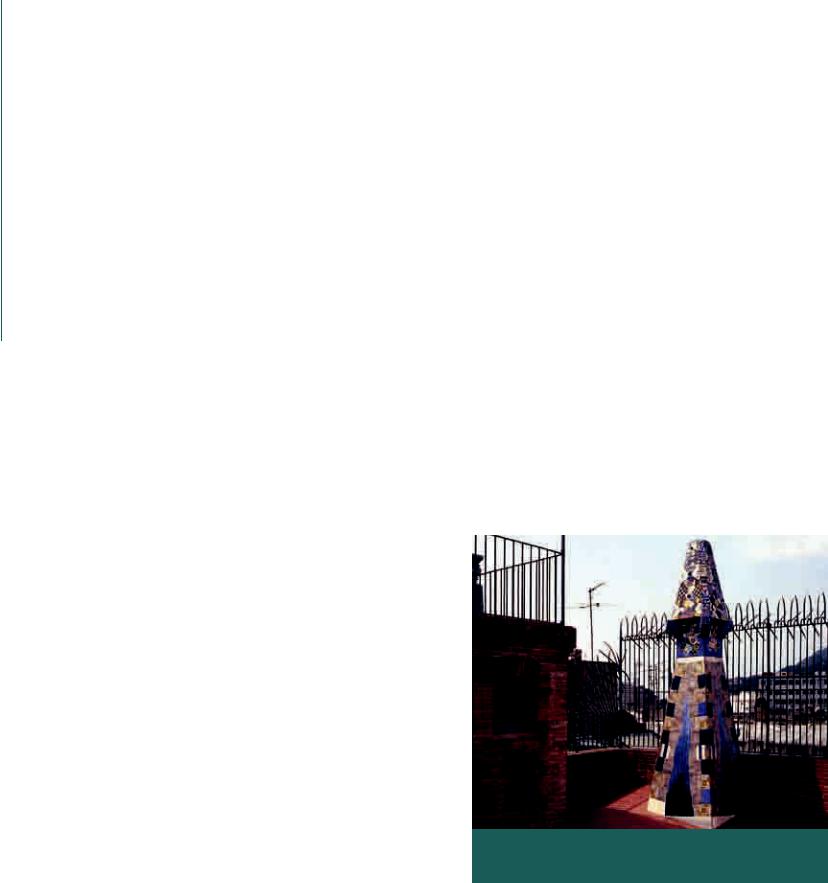
proposition, though more complex, was the clean-up operation of the element which crowns the needle, as it was necessary to dismantle and transport it to a workshop. The cone, the sphere and the wind star were polished, the copper points of the Franklin lightning conductor were cleaned and the brass mesh on the bat’s wings was replaced.
To recover the artificial lighting of the lantern was also an objective which could not be foregone. it was necessary to place a spotlight in each one of the small bows of the lower section of the needle to achieve the perceptíon from the interior, both during the day and during the night, of the effect of a celestial dome which Gaudí wanted to give the lantern. it was however not possible to learn what the original lamps were like (they must have been lit by gas), nor the primitive electrical installation which was introduced at a much later date (the one found dated from the ‘fifties), and it was decided to use the primitive support elements, which bad been conserved, to hold two copper arches through which the electrical installation runs and on which the lamps rest.
inside the needle, the ingenious wooden spiral structure bas been conserved which reinforces its stability against the wind, although according to the specialists it may be dangerous should an earthquake occur, as it can amplify the torsion effect. The result of the studies in course on the risk of earthquakes (carried out in collaboration with the university of La sapienza of Rome) may make it necessary in the future to choose between the assurance of conservation or the alteration of the formal and spatial authenticity of the mansion, or to introduce reinforcements which will be impossible to hide, both on the needle and on other parts of the building.
The twenty chimneys
on the flat roof is where most cases of harmonious diachrony have been found. one of them is the copper and glass platform which links the restored niche of the staircase with the ramp assessing the interior of the lantern. The date of the intervention has been inscribed on the glass: 1991. other cases were found in the treatment of the twenty chimneys of the roof, in which this generic eclecticism and elasticity have again been found, making it necessary to adapt the criterion of intervention to the different circumstances of each element.
some of the chimneys, such as those in open brickwork, had suffered serious alterations and to restore them the principle of mimesis was applied. a significant case was that of chimney no. 17, whose original trunk and cowls had been lost and had later been wrongly rebuilt, to judge by the original conserved documents. once it was analysed in detail, a version
closer to reality was drawn up. The chimney was completely dismantled and rebuilt in the same type of brick. Fortunately the ability of some of today’s builders is on a par with that of the craftsmen of Gaudi’s time. in the clad chimneys, in general well conserved, the restoration criteria have varied depending on the different circumstances and the degree of damage. Chimneys no. 11 (like the lantern, clad in sandstone) and 13 (in white marble) did not present any major problems. They were cleaned and the lost pieces were replaced. it was more complex to restore the new chimneys clad in ceramic tile, in a single piece, in regular fragments or trencadís (irregular fragments from broken pieces). as a norm, the restoration consisted of consolidating, cleaning and replacing lost materials, either with pieces which were identical to the original ones (found in fairs or antique dealers or expressly reproduced) or -when the original model was not available or not knownwith pieces which were similar in design, colours and age, trying to harmonize or contrast them with the adjacent pieces, depending on the general compositive scheme. For this it was necessary to analyse the tracings and chromatic combinations and to document all models of ceramic tiles (more than a hundred, most of them from the pujol y Baucís factory in esplugues de Llobregat, but also from Castellón and other places).
in the case of chimney no. 9, clad in fragments of white pottery, their origins were investigated (mostly it appared to come from dinner services from the pickman factory in seville) and it was verified, by analysing the mortar, which dated from previous
chimney nº 6 (antoni González). Photo: Montserrat Baldomà. 19.07.1994.
Capítulo 2 teoría, criterios e intervención |
61 |
|
|
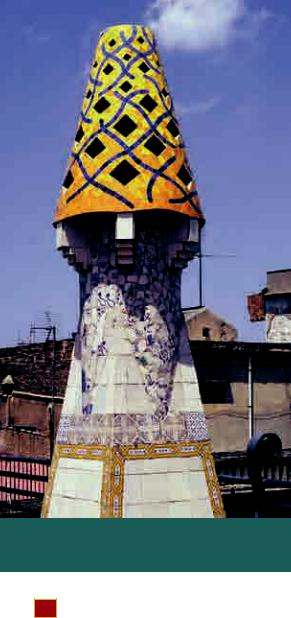
restorations. Some of the holes were filled in with pieces which had fallen and had been conserved. To substitute the losses, or those which were discarded because they were different from the original ones, fragments of old dinner services with similar characteristics were used, following the original pattern if it was known. On the sea-facing side of the trunk, whose original pattern was unknown, some contemporary designs were introduced -the logo of the Olympic Games and of Cobi, the mascotto leave a mark of the historic moment at which the restoration was carried out.
A different case, in which authenticity was also at risk, was that of the chimneys which with time had lost the original cladding of the cowls or had initially not been clad in their entirety, not due to Gaudí’s decision but for an unknown reason. The reflection in this case was: can a Gaudí chimney without cladding be
considered to be authentic? Is not the cladding an essential part of its authenticity? To transmit to future generations an element designed by Gaudí, but devoid of decoration, is that not to transmit mere rubble and not an authentic Gaudí creation?
When the chimneys were studied it was noted that during a restoration carried out in the ‘seventies, it was decided to fill in the bays of the base of chimney no. 8, which until then had always been empty, with ceramic pieces typical of those years and easily identified (although it was never known if this was intentional). In any case, the result was judged to be appropriate and the same criterion was adopted on the chimneys which presented naked bays or cowls. As regards the chimneys which did have decoration but had lost it, old documents were available which informed on the type of original material and, with more difficulty, on the primitive pattern and composition,
although of course not on the colour. It was decided to recover the cladding, respecting the type of original material, and their design was entrusted to various artists so that they could contribute their own creativity as a homage to Gaudí. The landscape of chimneys could thus recover an essential aspect of its authenticity: texture and colour.
The first chimneys to sport new cladding were nos. 5 and 6, where tiling was only preserved at the edges. As this was a first experience, the architects themselves created the design; Antonio González made no. 6 with industrial ceramic tiles in different shades of blue and grey, the colours present in the pieces used by Gaudí on the edges and the cowl. The material, broken up into elongated strips, and the smoke-like pattern are clearly diachronic with the primitive cladding. Chimney no. 5, on whose edges whole pieces in white were conserved, was the responsibility of Pau Carbó. He proposed a contrasting composition in yellow and orange pieces, expressly manufactured in the workshop El Sot, of Manuel Diestre and Joaquím Toribio. The base of chimney no. 7, which rests on the niche of the staircase, also had cladding on the edges only. The design of the three bays was entrusted to Domingo García-Pozuelo, architect and painter from Murcia who resides in la Rioja, who -with a figurative idea as a starting pointcreated an abstract composition materialized through manual tiles in twenty different colours and shades also manufactures by El Sot.
On the four façade chimneys not only the trencadís cladding on the trunks (ceramic on no. 1 and glass on the other three) had been clad, but their cowls also, as shown by the photographic documents. The design of the new cladding was entrusted to different artists on condition that the original geometry should not be altered and the same material used that was employed in the original cladding.
Cowl no. 1 was made by the sculptor, ceramist and painter Joan Gardy Artigas. The ceramic pieces were made in the ovens of the Llorens Artigas Foundation in Gallifa (Barcelona) and then placed on the chimney faithfully following the original play of planes of the cowl. The cladding in cathedral glass of no. 2 was designed by the painter and sculptor Robert Llimós and installed during the spring of 1994. At the same time the cladding of cowl no. 3 was made in three shades of green glass, which can be considered to be the collective work of the different artists and architects.
The Barcelona sculptor Joan Mora planned the cladding of cowl no. 4, in grey glass of different shades, crowning it with two hyper-realist details in stone: a small lizard facing the spectator and a rope which, seemingly abandoned, hangs at half height from the cowl. The cowl of chimney no. 10, with a
62 El Estudio y la Conservación de la Cerámica Decorada en Arquitectura
conical surface, was designed by the painter Gustavo Carbó Berthold, who composed it on the basis of interlinked lines in various blues on a background of yellows, colours which were present on the original cladding of the trunk and base.
The artificial lighting with which the work on the flat roof was crowned is far removed from the approach with which in many cases these installations are tackled: to avoid competing with natural light and to avoid any ostentation, but rather to highlight or suggest certain elements of an architecture which is always surprising, to create a fantastic and suggestive climate for nocturnal contemplation. Concentrated spotlights illuminate the weather vane and some of the cowls, not all of them, whereas through the skylights and windows of the niches a light emerges which, reflected on the brickwork of the walls and the ceramics of the flooring, seems to mysteriously envelop the surprised visitor. On the southern façade, the white light falling on the pavement also helps to strengthen this almost unreal climate which envelops the architecture of Gaudí.
Capítulo 2 Teoría, criterios e intervención |
63 |
|
|
